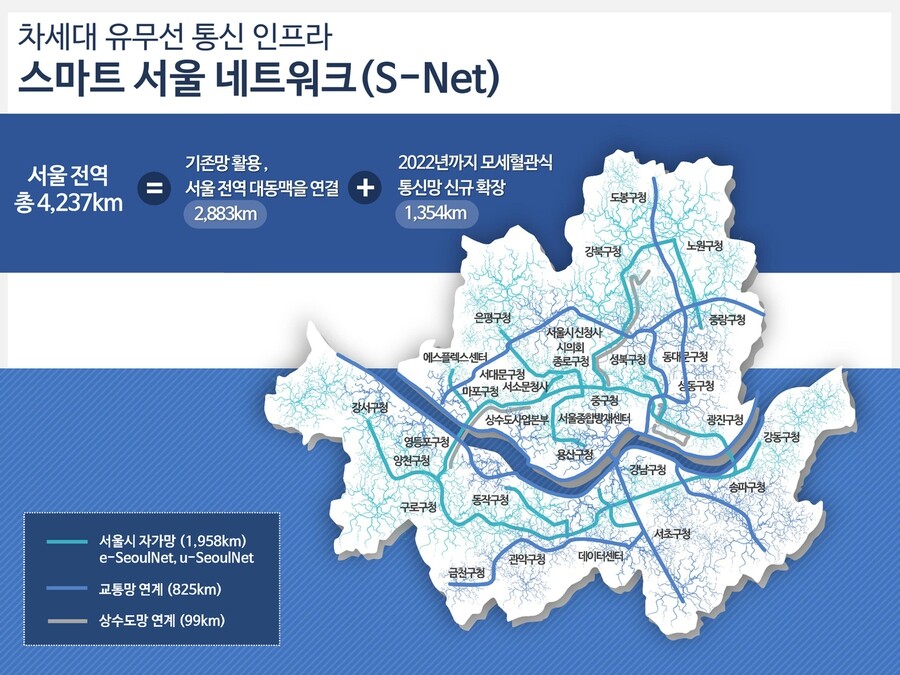hankyoreh
Links to other country sites 다른 나라 사이트 링크
Seoul to enable public Wi-Fi citywide by 2022

By 2022, free Wi-Fi will be available for people to use anywhere in the city of Seoul apart from its mountains. The city is planning to expand public Wi-Fi coverage from 31% of the living zone today to 100% by 2022.
On Oct. 7, the Seoul Metropolitan Government announced plans to install a 4,237-km independent communication network to make free public Wi-Fi available to citizens anywhere in the city. An independent communication network can be used without relying on lines from telecommunications providers. The “living zone,” defined as spaces where citizens go about their daily activities, covers around 326 square kilometers, or 54% of Seoul’s total area, and consists of eight components: land, roads, parks, historic sites, water and sewage infrastructure, athletic facilities, parking facilities, and recreational areas. An Internet of Things (IoT) network for public institutions to use is also being expanded through the city, with public services including shared parking, smart streetlights, and disappearance prevention to be made available through the use of IoT sensors.
The project is part of S-Net (Smart Seoul Network), an effort planned last July. Its aim is to reduce communication costs for ordinary people by extending a “capillary” model of Wi-Fi network through the living zone to serve as a smart city base. The new public Wi-Fi is chiefly to be installed in densely populated regions, including major roads in downtown Seoul, subways, and public parks. The plan also provides for project cost reductions by focusing the installation of wireless transmission and reception equipment on areas where an independent communication network already exists and can be used without relying on telecom networks – including streetlights, traffic signals, security lights, and closed-circuit television units. Communication networks previously established for the city, workplaces, and districts will also be integrated for use as resources to provide public Wi-Fi.
A total of 7,420 public Wi-Fi access points (APs) are currently operating in central Seoul. As part of the project, the city plans to install another 16,330 APs through 2022. The city predicts savings of up to 630,000 won (US$527.60) per resident in annual communication costs once the project is finished in 2022. The amount of potential communication cost savings has been estimated at 3.88 trillion won (US$3.25 billion) per year with the use of public Wi-Fi by 6.12 million Seoul residents. The S-Net project budget amounts to 102.7 billion won (US$86.01 million) total for the three-year period from 2020 to 2022.
“At a time when smartphones have become a living essential, the S-Net project will ensure basic communication rights for everyone,” said Lee Won-mok, a smart city policy official for the city of Seoul.
“By providing thorough smart city infrastructure throughout the city of Seoul, we will be creating a superconnected smart city where people and things are all linked to the network,” Lee said.
By Lee Jeong-gyu, staff reporter
Please direct comments or questions to [english@hani.co.kr]

Editorial・opinion
![[Column] Park Geun-hye déjà vu in Yoon Suk-yeol [Column] Park Geun-hye déjà vu in Yoon Suk-yeol](https://flexible.img.hani.co.kr/flexible/normal/500/300/imgdb/original/2024/0424/651713945113788.jpg) [Column] Park Geun-hye déjà vu in Yoon Suk-yeol
[Column] Park Geun-hye déjà vu in Yoon Suk-yeol![[Editorial] New weight of N. Korea’s nuclear threats makes dialogue all the more urgent [Editorial] New weight of N. Korea’s nuclear threats makes dialogue all the more urgent](https://flexible.img.hani.co.kr/flexible/normal/500/300/imgdb/original/2024/0424/7317139454662664.jpg) [Editorial] New weight of N. Korea’s nuclear threats makes dialogue all the more urgent
[Editorial] New weight of N. Korea’s nuclear threats makes dialogue all the more urgent- [Guest essay] The real reason Korea’s new right wants to dub Rhee a founding father
- [Column] ‘Choson’: Is it time we start referring to N. Korea in its own terms?
- [Editorial] Japan’s rewriting of history with Korea has gone too far
- [Column] The president’s questionable capacity for dialogue
- [Column] Are chaebol firms just pizza pies for families to divvy up as they please?
- [Column] Has Korea, too, crossed the Rubicon on China?
- [Correspondent’s column] In Japan’s alliance with US, echoes of its past alliances with UK
- [Editorial] Does Yoon think the Korean public is wrong?
Most viewed articles
- 1‘We must say no’: Seoul defense chief on Korean, USFK involvement in hypothetical Taiwan crisis
- 2[Reportage] On US campuses, student risk arrest as they call for divestment from Israel
- 3[Column] Park Geun-hye déjà vu in Yoon Suk-yeol
- 4‘Weddingflation’ breaks the bank for Korean couples-to-be
- 5Korea sees more deaths than births for 52nd consecutive month in February
- 6N. Korean delegation’s trip to Iran shows how Pyongyang is leveraging ties with Moscow
- 7Amnesty notes ‘erosion’ of freedom of expression in Korea in annual human rights report
- 8Will NewJeans end up collateral damage in internal feud at K-pop juggernaut Hybe?
- 9N. Korean hackers breached 10 defense contractors in South for months, police say
- 10[Guest essay] The real reason Korea’s new right wants to dub Rhee a founding father